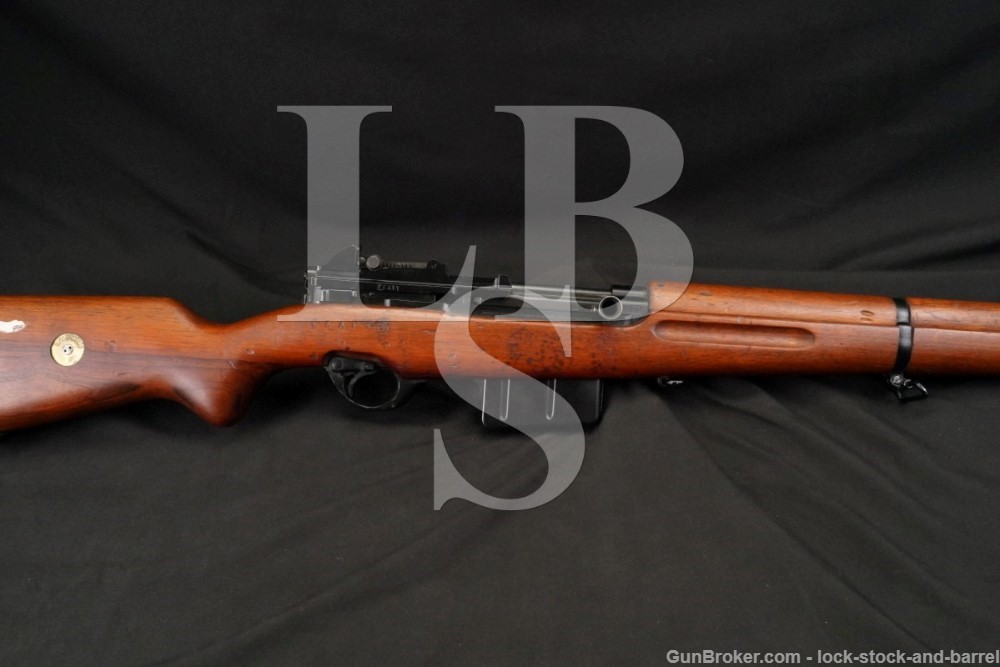
Egyptian Army FN49 FN-49 8mm Mauser 23″ Semi-Automatic Rifle Ca 1948-52 C&R
Sold for $2059.86
The FN-49 was a rifle designed by the Belgian arms manufacturer Fabrique Nationale Herstal during the 1940s. The firm was working on the now largely forgotten M1914 semi-automatic rifle but the work was disrupted when Germany conquered Belgium at the beginning of WWI. It would not be until the early 1930s when FN began to resume work on semi-automatic rifles and in 1936 Dieudonne Saive patented a prototype. Again, FN’s attempt at producing a semi-automatic rifle was disrupted by a German invasion, this time in 1940 during WWII. Saive refused to allow his design to fall into the hands of the Wehrmacht, and managed to escape to England in 1941. While in England, Saive continued to refine his design. By the end of WWII Saive had nearly perfected his design and following some final refinements the gun was ready for the market. Finally, in 1948 FN secured a contract for the new rifle from Venezuela and soon more than two dozen other nations would place orders for the new gun. The gun saw frontline service during a number of conflicts during the 1950s including with Belgian forces sent to suppress pro-independence forces in Congo and during the Suez Crisis Egyptian forces employed the rifle against a joint Israeli, British and French invasion force. The gun was a stalwart design, but it became obsolete by the end of the 1950s and was superseded by more modern automatic rifles during the 1960s. The gun has earned a reputation as the last true pre-modern firearm.
This particular specimen is a Egyptian contract FN-49 which was supplied to the nation sometime between 1948-1952. Egypt had secured nominal independence from Britain in the 1920s with a Monarchy left in power, but the country was still heavily influenced by London. The country was still a monarchy when after WWII it placed a massive order for FN-49 rifles from the Belgium based arms company Fabrique Nationale. The rifles supplied by FN to Cairo had a distinct marking on the chamber ring indicating they were supplied when the monarchy was still in power. The geopolitical situation took a massive turn when in 1952 a group of Egyptian military officers launched a coup against the monarchy and declared Egypt a Republic, largely putting an end to British influence in the country.
Following a power struggle a young military officer Gamal Abdel Nasser assumed power and began to align the nation with the Soviet Union, although the British still had leverage in Egypt, including control over the strategically vital Suez Canal. In 1956 Nasser nationalized the Suez Canal, which ultimately resulted in a joint British, French and Israeli invasion of Egypt. The Egyptian Army was armed with an odd assortment of Soviet and Western arms including the FN-49, but the invading forces were simply better equipped and the Egyptian Army began to crumble. The Soviet Union ultimately threatened to intervene, with nuclear weapons if necessary, to prevent the destruction of Egypt and to the surprise of the British led invasion force American President Dwight Eisenhower refused to challenge the Soviets which resulted in a political defeat for the British and French with British Prime Minister Anthony Eden being forced to step down in humiliation. Conversely, Israel annexed the Sinai Peninsula and gained several other strategic objectives at the expense of Egypt, actions which laid the seed for future conflict between the two powers. This conflict saw the most widespread use of Egyptian FN49 Rifles, the rifle had been superseded when Egypt began to engage in large scale hostilities again in the ensuing decade.
This particular specimen is an Egyptian contract FN-49 which was made by Fabrique Nationale. It was supplied to Egypt sometime between 1948-1952. The rifle’s stock and receiver are matching, but the bolt, bolt carrier and receiver cover are taken from another gun. The rifle has all the features that are unique to the Egyptian Rifles including a brass butt-plate, a brass stock disc (please note, many reproductions of varying quality have been added to surplus Egyptian FN-49s and we cannot verify the authenticity of the stock disc), Egyptian markings, a muzzle-cap designed to accommodate a scabbard bayonet and a distinct receiver cover. The rifle is nicely preserved considering its age and the chaotic period of Egyptian history it is from. This is a great option for historical firearms collectors.
